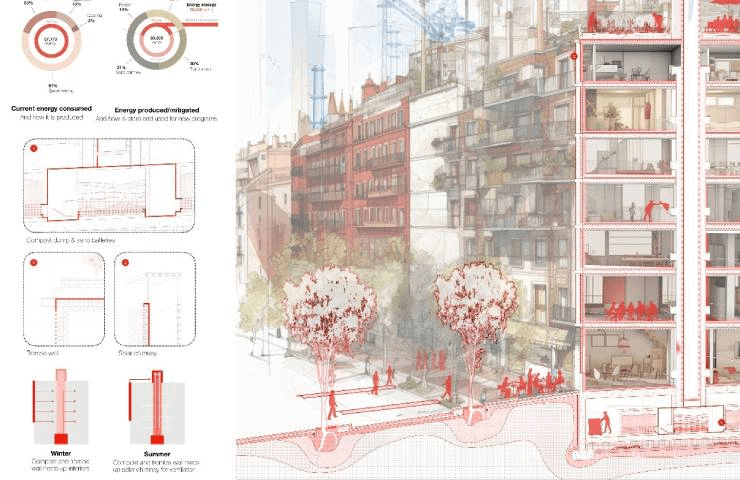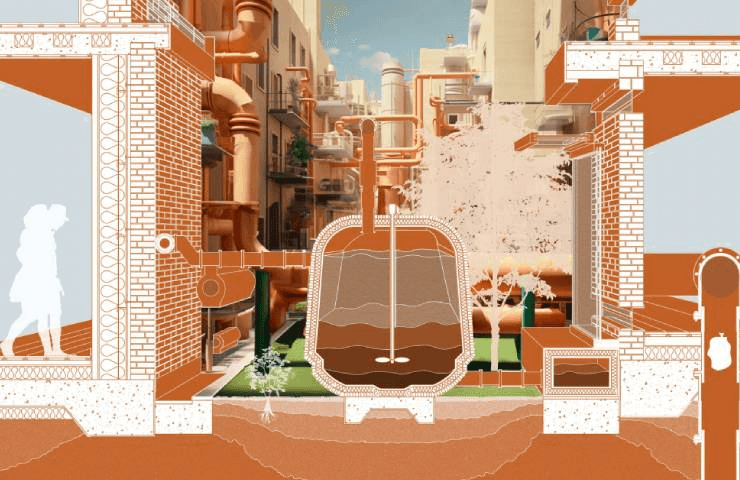IE School of Architecture and Design Students Reimagine Madrid’s Urban Infrastructure with AI

Researcher Cem S. Kayatekin and IE University architecture students explore AI’s role in rethinking Madrid’s energy and water systems.
Madrid, 30 April 2025 - In a recent study published in Environmental Science and Sustainable Development, researcher Cem S. Kayatekin at IE School of Architecture and Design examines the role of artificial intelligence (AI) in rethinking energy and water infrastructure in Madrid through a case study of a fifth-year undergraduate architecture studio.
Madrid, like many cities, has traditionally relied on a top-down approach, and centralized, systems to manage water and energy. These models can be susceptible to system failures, low resilience, environmental stressors, and resource distribution challenges. Kayatekin’s fifth year studio asks students to explore a hybrid model that integrates decentralized systems while maintaining certain advantages of centralized networks.
The study is based on a three-week course in which students used AI tools such as ChatGPT and Midjourney to support research, refine urban planning concepts, and generate architectural visualizations. The course led to four proposals, out of which three were described in the study.
Energetic Madrid, by Ghofrane Benajiba, Daniela Figueroa, Nathan Robert, and Tristan Sartorius explores a net-positive-energy urban system across different scales, integrating solar heat chimneys, Trombe walls, biomass heating, seasonal thermal storage, and photovoltaics. It emphasizes reducing energy footprints, recovering industrial heat, and adopting a fifteen-minute city model. The result is a mixed-use, low-carbon urban environment with surplus energy stored as heat for long-term use.
F(l)ood Harvest by Alara Aykanat, Yusuf Bozkurt, Daphné Fournel, and Martin Jitenski envisions a future water infrastructure across domestic, street, superblock, neighborhood, and city scales to manage extreme drought and flooding. Set 150 years ahead, it examines sociocultural, political, and economic dynamics in water-scarce conditions. Key elements include blue-green roofs, rainwater harvesting, bioswales, permeable hardscaping, blackwater/greywater remediation, and multimodal street design, creating a resilient urban environment.
Waterkeepers by Nadine Fahmy, Malek Fleifel, Roché Rabie, and Carolina Schönburg explores a flood-and drought-tolerant water infrastructure across building, boulevard, block, plaza, and city scales in Madrid, aligning with fifteen-minute city principles. Key strategies include green roofs, rainwater harvesting, bioswales, permeable hardscaping, decentralized water remediation, and soil-based carbon sequestration. The resulting urban model integrates nature-based water management with mixed-use, climate-resilient development.
Mushroom Kingdom by Ida Wolfenson, Marina Lopez, Isabella Espinal, and Maria Cassano. The project explores a rebooting of Madrid, with a focus around more-localized energy production and closed loop systems—specifically delving into the apartment, building, courtyard, block, and superblock scales of the city. Key areas of focus include renewable energy integration, closed-loop waste management, passive cooling strategies, decreased energy and carbon footprints, blue-green-grey infrastructure, localized energy production, and the incorporation of 15-minute city parameters across scales.
While AI contributed to research efficiency and design iteration, the study also identified certain limitations. AI-generated inaccuracies, sometimes referred to as “hallucinations,” logical fallacies, and clear errors that required human intervention for verification and refinement. Rather than replacing human decision-making, AI served as a tool for analysis and iterative development. The study also observed that AI influenced discussions, functioning as a neutral element in debates and helping to identify inconsistencies in planning narratives. Kayatekin suggests that this aspect of AI may have broader implications for education and professional practice in architecture and urban planning.
The research concludes that while AI is increasingly being incorporated into built environment planning, it is dominantly regarded as a tool for quantitative analysis. The study highlights its potential role in qualitative aspects of urban design. As cities like Madrid address infrastructure challenges, AI-based planning methods may contribute to innovative and more-integrated solutions. The study acknowledges that AI’s role continues to evolve, with ongoing assessments needed to determine its long-term impact.
Read the full research paper titled "A.I. and the rewiring of Madrid: Narratives of Water, Energy, and the Built World" published on March 27, 2025 in Vol. 10, Issue 1, "Building Resilient Cities: Integrating Sustainability, Climate Adaptation, and Urban Resilience" of Environmental Science and Sustainable Development .



